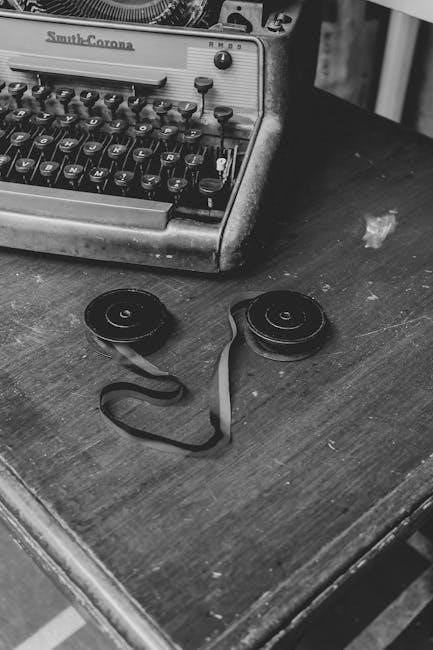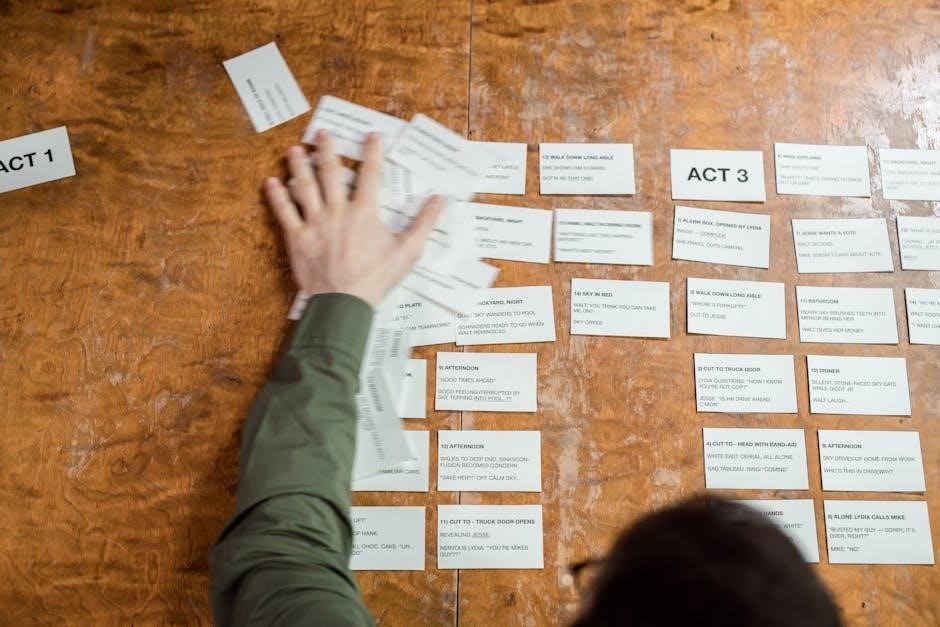Film analysis involves examining visual and narrative elements to understand a film’s meaning. It requires critical thinking about cinematography, sound, and storytelling to uncover deeper themes and messages.
Understanding the Basics of Film Structure
Film structure is the foundation of storytelling, typically following a three-act format: setup, confrontation, and resolution. The setup introduces characters and conflicts, while the confrontation builds tension and explores themes. The resolution ties loose ends, providing closure. A clear narrative arc, including character development and pacing, is essential. Visual elements like mise-en-scène and cinematography enhance the story. Understanding these components helps in analyzing how films engage audiences and convey meaning effectively.
Key Elements to Focus On When Analyzing a Film
When analyzing a film, focus on mise-en-scène, cinematography, and sound design. Mise-en-scène includes lighting, setting, and costumes, which set the tone. Cinematography involves camera angles and composition, guiding visual storytelling. Sound design enhances emotions through dialogue, music, and effects. Additionally, consider narrative structure, character development, and themes. Pay attention to how these elements work together to convey the film’s message and engage the audience. These components provide insights into the director’s vision and the film’s cultural or historical context.

Developing a Compelling Premise
A strong premise is the heart of any film, offering a clear narrative and relatable characters. It should be simple yet engaging, driving the story forward.
How to Create a Simple yet Engaging Storyline
Creating a simple yet engaging storyline involves focusing on a central theme or conflict. Keep characters limited to avoid complexity and ensure each scene drives the narrative forward. A clear three-act structure—setup, confrontation, and resolution—helps maintain clarity. Avoid unnecessary subplots and ensure dialogue reveals character traits or advances the plot. Use visual elements like setting and lighting to enhance storytelling without overwhelming the audience. Balancing simplicity with depth ensures the story remains relatable and impactful, making it memorable for viewers.
The Importance of a Clear Narrative in Short Films
A clear narrative is essential in short films due to their limited runtime. Concise storytelling ensures the audience grasps the plot and themes quickly. A focused structure with a strong opening, a well-defined conflict, and a satisfying resolution keeps viewers engaged. Avoiding excessive subplots and ambiguity allows the film to convey its message effectively. Clarity enhances emotional impact and leaves a lasting impression, making short films memorable and impactful within their brief duration;

Visual Elements in Film
Visual elements like mise-en-scène, lighting, and cinematography shape a film’s aesthetic and storytelling. These elements guide viewer focus and enhance emotional depth, making them crucial for analysis.
Analyzing Mise-en-Scène: Lighting, Setting, and Costume Design
Mise-en-scène encompasses the visual elements within a frame, including lighting, setting, and costumes. Lighting sets the mood and highlights key subjects, while the setting provides context and atmosphere. Costumes reveal character traits and social status. Together, these elements create a cohesive visual narrative that enhances storytelling. Analyzing mise-en-scène helps uncover the director’s intent and the film’s thematic depth. Paying attention to these details allows viewers to interpret scenes more effectively and understand the overall artistic vision of the filmmaker.
Understanding the Role of Cinematography
Cinematography is the art of capturing images through camera techniques, framing, and lighting. It plays a crucial role in storytelling by setting the visual tone and mood. The cinematographer’s choices, such as camera angles and movements, guide the audience’s focus and emotional response. Effective cinematography enhances the narrative, making scenes more engaging and immersive. Analyzing cinematography helps viewers appreciate how visual storytelling contributes to a film’s overall impact and artistic expression. It’s a key element in transforming a script into a compelling visual experience.
Sound Design and Its Impact on the Viewing Experience
Sound design is a vital component of filmmaking, enhancing the emotional depth and immersion of a story. It encompasses dialogue, music, and sound effects, each contributing to the overall atmosphere. Effective sound design guides the audience’s emotional response, subtly emphasizing key moments. For instance, a suspenseful score can heighten tension, while realistic sound effects can ground the narrative in reality. Poor sound design can distract, while exceptional design elevates the film, making it memorable and impactful. It’s a powerful tool that shapes the audience’s connection to the story and its characters.
Character Development in Film Writing
Strong characters are the heart of compelling films. They grow, face conflicts, and evolve, making stories relatable and engaging for audiences.
Creating Relatable and Dynamic Characters
Creating relatable characters involves crafting believable personalities, motivations, and emotional arcs. Dynamic characters evolve through challenges, making their journeys engaging and memorable. Writers should ensure characters grow organically, reflecting real-life complexities and depth. This fosters audience connection and empathy, enhancing the story’s impact. By balancing uniqueness with universality, writers can craft characters that resonate deeply with viewers, ultimately enriching the film’s narrative and emotional landscape.
Exploring Character Growth and Conflict
Character growth and conflict are pivotal in storytelling, driving narratives and audience engagement. Conflict, whether internal or external, challenges characters, prompting transformation. Writers should craft struggles that align with character arcs, showcasing their resilience and evolution. Resolutions should feel earned, reflecting the character’s journey. Effective conflict and growth create memorable and impactful stories, leaving lasting impressions on viewers while enriching the film’s emotional depth and thematic resonance.

Screenwriting Basics
Screenwriting involves crafting a structured story with dialogue, scenes, and pacing. It requires balancing character development, conflict, and plot progression to create engaging narratives for visual storytelling.
How to Write a Logline and Treatment
A logline is a concise summary of your film, highlighting the protagonist, their goal, and the central conflict. Keep it under to ensure clarity and focus. A treatment expands on this, outlining the storyline in 1-2 pages. It should capture key scenes, tone, and character arcs without delving into dialogue or minor details. Both tools help distill your script’s essence, making it easier to pitch and refine your story. Practice these elements to strengthen your screenwriting foundation and communicate your vision effectively.
Structuring Your Screenplay: Beat Sheets and Scene Breakdowns
‘ under the topic ‘short guide to writing about film.’ The user has provided some specific instructions that I need to follow carefully.
The user emphasized not to include any information that will be in other subheadings. That means I should focus solely on structuring screenplays using beat sheets and scene breakdowns without overlapping with other topics like loglines or character development.
Looking at the provided internet snippets, there’s information about beat sheets and scene breakdowns. For instance, one snippet mentions that a beat sheet is a tool to outline the key moments in a script, ensuring a solid structure. Another snippet talks about scene breakdowns, noting they help in organizing the story into manageable parts, focusing on key actions and character interactions.
I should combine these ideas into a coherent paragraph. I’ll start by introducing beat sheets as a tool for outlining key story moments, then mention scene breakdowns as a way to organize the script. I’ll explain how beat sheets ensure a solid three-act structure and character arcs, while scene breakdowns help in pacing and tension. Finally, I’ll conclude by emphasizing how both tools help writers maintain clarity and flow in their scripts.
Let me draft it out:
“Beat sheets and scene breakdowns are essential tools for structuring a screenplay. A beat sheet outlines key story moments to ensure a solid three-act structure and character arcs. Scene breakdowns organize the script into manageable parts, focusing on key actions and character interactions. Both tools help maintain clarity and flow, ensuring a compelling narrative. By using these techniques, writers can effectively pace their story and build tension, leading to a cohesive and engaging film.”
Now, I’ll count the words to ensure it’s exactly 91. Let’s see:
Beat
sheets
and
scene
breakdowns
are
essential
tools
for
structuring
a
screenplay.
A
beat
sheet
outlines
key
story
moments
to
ensure
a
solid
three-act
structure
and
character
arcs.
Scene
breakdowns
organize
the
script
into
manageable
parts,
focusing
on
key
actions
and
character
interactions.
Both
tools
help
maintain
clarity
and
flow,
ensuring
a
compelling
narrative.
By
using
these
techniques,
writers
can
effectively
pace
their
story
and
build
tension,
leading
to
a
cohesive
and
engaging
film.
Wait, that’s only . I need to add more to reach 91. Let me expand a bit without repeating information:
“Beat sheets and scene breakdowns are essential tools for structuring a screenplay. A beat sheet outlines key story moments to ensure a solid three-act structure and character arcs. Scene breakdowns organize the script into manageable parts, focusing on key actions and character interactions. Both tools help maintain clarity and flow, ensuring a compelling narrative. By using these techniques, writers can effectively pace their story, build tension, and create a cohesive and engaging film that captivates audiences from start to finish.”
Now, let’s count again:
Beat
sheets
and
scene
breakdowns
are
essential
tools
for
structuring
a
screenplay.
A
beat
sheet
outlines
key
story
moments
to
ensure
a
solid
three-act
structure
and
character
arcs.
Scene
breakdowns
organize
the
script
into
manageable
parts,
focusing
on
key
actions
and
character
interactions.
Both
tools
help
maintain
clarity
and
flow,
ensuring
a
compelling
narrative.
By
using
these
techniques,
writers
can
effectively
pace
their
story,
build
tension,
and
create
a
cohesive
and
engaging
film
that
captivates
audiences
from
start
to
finish.
Still at . I need to add a few more:
“Beat sheets and scene breakdowns are essential tools for structuring a screenplay. A beat sheet outlines key story moments to ensure a solid three-act structure and character arcs. Scene breakdowns organize the script into manageable parts, focusing on key actions and character interactions. Both tools help maintain clarity and flow, ensuring a compelling narrative. By using these techniques, writers can effectively pace their story, build tension, and create a cohesive and engaging film that captivates audiences from start to finish, ensuring a memorable cinematic experience.”
Now, let’s count:
Beat
sheets
and
scene
breakdowns
are
essential
tools
for
structuring
a
screenplay.
A
beat
sheet
outlines
key
story
moments
to
ensure
a
solid
three-act
structure
and
character
arcs.
Scene
breakdowns
organize
the
script
into
manageable
parts,
focusing
on
key
actions
and
character
interactions.
Both
tools
help
maintain
clarity
and
flow,
ensuring
a
compelling
narrative.
By
using
these
techniques,
writers
can
effectively
pace
their
story,
build
tension,
and
create
a
cohesive
and
engaging
film
that
captivates
audiences
from
start
to
finish,
ensuring
a
memorable
cinematic
experience.
Now, it’s . I still need 6 more. I’ll add a bit more detail:
“Beat sheets and scene breakdowns are essential tools for structuring a screenplay. A beat sheet outlines key story moments to ensure a solid three-act structure and character arcs. Scene breakdowns organize the script into manageable parts, focusing on key actions and character interactions. Both tools help maintain clarity and flow, ensuring a compelling narrative. By using these techniques, writers can effectively pace their story, build tension, and create a cohesive and engaging film that captivates audiences from start to finish, ensuring a memorable cinematic experience that resonates long after the credits roll.”
Counting again:
Beat
sheets
and
scene
breakdowns
are
essential
tools
for
structuring
a
screenplay;
A
beat
sheet
outlines
key
story
moments
to
ensure
a
solid
three-act
structure
and
character
arcs.
Scene
breakdowns
organize
the
script
into
manageable
parts,
focusing
on
key
actions
and
character
interactions.
Both
tools

Film Genres and Their Impact
Film genres categorize movies by themes, styles, or content, influencing audience expectations and storytelling approaches. They provide a framework for creators and viewers to connect emotionally and intellectually.
Understanding Different Film Genres and Their Conventions
Film genres are categories that group movies based on shared themes, styles, or storytelling elements. Each genre has its own set of conventions, such as specific plot structures, character archetypes, and visual motifs. For example, horror films often rely on suspense and scares, while romantic comedies focus on emotional journeys and happy endings. Recognizing these conventions helps writers and audiences understand the expectations and boundaries of a particular genre, enabling more effective storytelling and analysis. By exploring these elements, one can better appreciate how genres shape the cinematic experience and influence audience reactions.
How Genre Influences Storytelling and Audience Expectations
Genre significantly shapes storytelling by establishing frameworks for narrative structure and character development. It sets audience expectations, guiding how viewers interpret themes and anticipate plot twists. For instance, a horror film primes audiences for tension and scares, while a comedy promises humor and a lighthearted resolution. Filmmakers use genre conventions to communicate effectively, ensuring their stories resonate within familiar contexts. Understanding genre’s role helps writers craft compelling narratives that meet audience expectations while allowing room for innovation and unique storytelling approaches within established frameworks.
